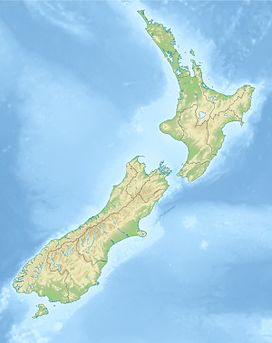
The Waipā River is in the Waikato region of the North Island of New Zealand. The headwaters are in the Rangitoto Range east of Te Kūiti. It flows north for 115 kilometres (71 mi), passing through Ōtorohanga and Pirongia, before flowing into the Waikato River at Ngāruawāhia. It is the Waikato's largest tributary. The Waipā's main tributary is the Puniu River.
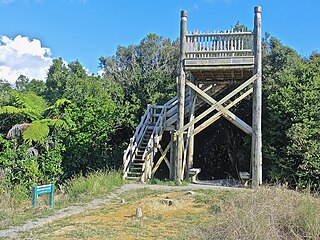
Hakarimata Range is a range of hills on the western edge of Ngāruawāhia township, in the Waikato region of New Zealand, overlooking the confluence of the Waikato and Waipā Rivers. The Hakarimata Range is separated from the Taupiri Range by the Taupiri Gorge, through which the Waikato River flows.

The Moehau Range is the northernmost range on the Coromandel Peninsula, extending from the settlement of Colville, New Zealand northwards to the tip of the peninsula. Mount Moehau is the highest point of the range, at 892m above sea level.

The Awakino River is a river located in the North Island of New Zealand. It has been described as one of the great rivers in the North Island providing top-quality backcountry fishing. Awakino township lies on its river banks. It rises on peaks of up to 762 m (2,500 ft) in the Herangi Range and flows 75 km (47 mi), initially southerly and then through Awakino Gorge in a south-westerly direction.

The Manaia River is a river of the Coromandel Peninsula in New Zealand's North Island. It flows north from its sources in the Coromandel Range, reaching the Hauraki Gulf at Manaia Harbour, 10 kilometres (6 mi) southwest of Coromandel.
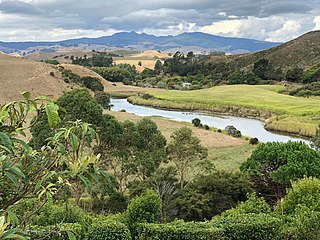
The Ōpārau River is a river of the Waikato Region of New Zealand's North Island in the area occupied by Ngāti Hikairo. It flows southwest from its sources in the Pirongia Forest Park, the highest being The Cone, and flows into the Kawhia Harbour, 5 kilometres (3 mi) east of Kawhia. The river has about 171 km (106 mi) of tributaries.

Rukuhia railway station was a flag station on the North Island Main Trunk in New Zealand, located in the settlement of Rukuhia. It was established during an extension of the railway line in the 1870s. The service started with two trains a day.
The Paeroa-Pokeno railway line or deviation in the upper North Island of New Zealand between Paeroa on the East Coast Main Trunk (ECMT) and Pokeno on the North Island Main Trunk (NIMT) was a proposed route with construction started but abandoned. The proposal has been revived in recent years as part of a more direct route between Auckland and Tauranga.
Horotiu is a small township on the west bank of the Waikato River in the Waikato District of New Zealand. It is on the Waikato Plains 13 km (8.1 mi) north of Hamilton and 5 km (3.1 mi) south of Ngāruawāhia. From early in the 20th century it developed around a freezing works and other industries.

Marokopa is a rural community in Waitomo District and Waikato region of New Zealand. It is located close to the coast between Awakino and Kawhia Harbour. The meshblock includes the coastal township of Marokopa, at the mouth of the Marokopa River, and the south side of the small village of Awamarino, about 10 km (6.2 mi) upstream.
The Mangatangi River, or Mangatangi Stream, originates on the eastern slopes of the Hunua Ranges in New Zealand and flows roughly southwards until it is joined by the Ruaotehuia Stream just north of State Highway 2 between Mangatāwhiri and Maramarua, where it becomes the Maramarua River. Mangatangi can be translated as manga tangi to stream of weeping, or as rippling stream, or babbling brook.

Whitikahu is a settlement scattered along Whitikahu Rd in the Waikato District and Waikato region of New Zealand's North Island.

Hapuakohe Range of hills is aligned north–south, between the Waikato River and the Hauraki Plains in the Waikato region of New Zealand. It is separated from the Taupiri Range by an air-gap at Mangawara, where the Waikato flowed about 20,000 years ago.
Waikawau is a rural community in the Waitomo District and Waikato region of New Zealand's North Island, beside Waikawau River.
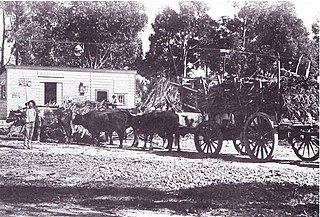
Te Kauwhata was a flag station on the North Island Main Trunk line, in the Waikato District of New Zealand, 54 mi (87 km) south of Auckland. It was 591.52 km (367.55 mi) north of Wellington, 3.32 km (2.06 mi) north of Rangiriri, 6.72 km (4.18 mi) south of Whangamarino and 12 m (39 ft) above sea level.

Kakahi was a station on the North Island Main Trunk line, in the Ruapehu District of New Zealand, serving Kakahi. It formally opened on 9 November 1908. The rails were laid south of Piriaka by May 1904 and a daily ballast train was running by October, which also carried passengers. Kakahi Bridge has five spans of 44 ft (13 m) and one of 23 ft (7.0 m) supplied by G. Fraser & Sons of Auckland, which delayed construction to the south. It crosses the Kakahi Stream, which was sometimes called the Waitea River.

Te Rore was in the 1850s an important transhipment point on New Zealand's Waipā River, between the agriculture of the Waikato basin and its Auckland market. That was ended in 1864 by the Invasion of the Waikato, when Te Rore was, for a few months, part of the supply route to four redoubts set up nearby. It is now a rural community in the Waipa District, 6 km (3.7 mi) north of Pirongia and roughly the same distance south of Ngāhinapōuri on State Highway 39.

Piripiri is a sparsely populated area in the Manawatū-Whanganui region, on State Highway 2 and the Palmerston North–Gisborne line. It is 3 mi 8 ch (5.0 km) north of Dannevirke, and has 150 people scattered over a meshblock of 21.8 km2 (8.4 sq mi).
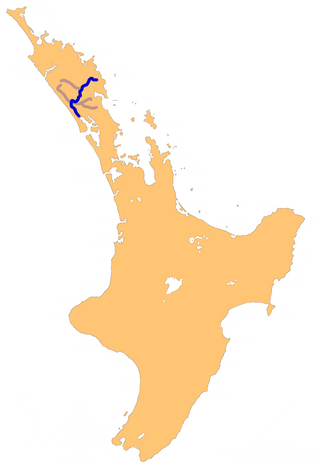
The Awakino River is a river of the Kaipara District in Northland Region. It flows 38 km (24 mi), generally south from the Awakino Stream, which rises on the Tutāmoe Range, to reach the Wairoa River on the eastern edge of Dargaville. The river is crossed by SH14 and the mothballed Dargaville Branch railway.

The Waikawau River is the name of two rivers on the Coromandel Peninsula in New Zealand's North Island, which each have nearby settlements called Waikawau. The more southerly flows generally west from its sources in the Coromandel Range, reaching the Firth of Thames at Waikawau Beach. This river flows south east off the Moehau Range to join the Pacific in Waikawau Bay. Both rivers were officially named on 21 June 2019.

